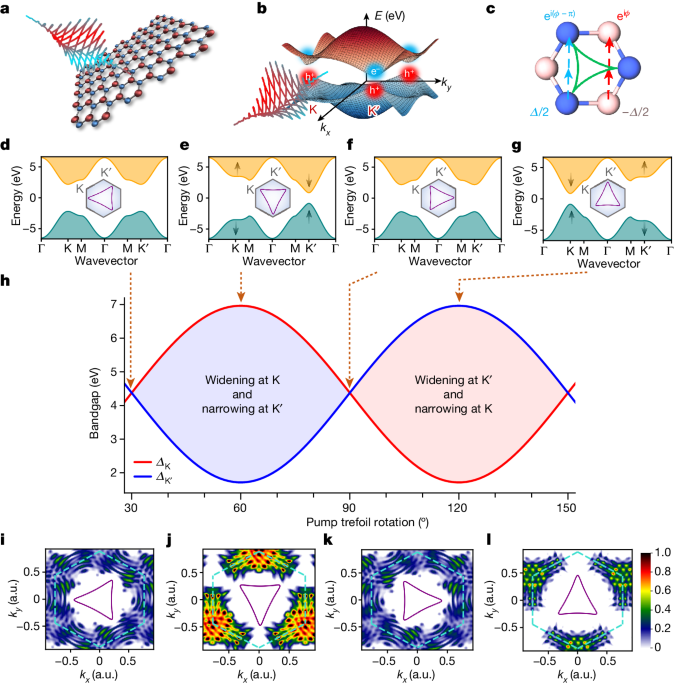Ultrafast Optical Control of Topological Phases in Monolayer Hexagonal Boron Nitride
Centrala begrepp
Tailoring the spatial symmetry of light waveforms to match the lattice of a hexagonal boron nitride monolayer enables optical control of time-reversal symmetry breaking and the realization of the topological Haldane model, allowing ultrafast switching between band structure configurations.
Sammanfattning
The content describes a novel approach to manipulate the electronic properties of a monolayer of hexagonal boron nitride using tailored light waveforms. By matching the spatial symmetry of the light waveform to the lattice of the material, the researchers were able to optically induce time-reversal symmetry breaking and realize the topological Haldane model in this two-dimensional insulating crystal.
The key highlights are:
- Tailoring the spatial symmetry of the light waveform to match the lattice of hexagonal boron nitride monolayer
- Twisting the light waveform to optically control time-reversal symmetry breaking
- Realization of the topological Haldane model in the laser-dressed two-dimensional crystal
- Ability to control the parameters of the effective Haldane-type Hamiltonian by rotating the light waveform
- Enabling ultrafast switching between band structure configurations and unprecedented control over the bandgap
- Resulting in an asymmetric population between complementary quantum valleys, leading to a measurable valley Hall current
- The universality and robustness of this scheme paves the way for valley-selective bandgap engineering and the creation of few-femtosecond switches with quantum degrees of freedom.
Anpassa sammanfattning
Skriv om med AI
Generera citat
Översätt källa
Till ett annat språk
Generera MindMap
från källinnehåll
Besök källa
www.nature.com
Light-wave-controlled Haldane model in monolayer hexagonal boron nitride - Nature
Statistik
Monolayer hexagonal boron nitride is a two-dimensional insulating crystal.
Tailoring the spatial symmetry of the light waveform to match the lattice of the material enables optical control of time-reversal symmetry breaking.
Twisting the light waveform results in the realization of the topological Haldane model in the laser-dressed two-dimensional crystal.
Rotating the light waveform allows control over the parameters of the effective Haldane-type Hamiltonian, enabling ultrafast switching between band structure configurations.
The asymmetric population between complementary quantum valleys leads to a measurable valley Hall current.
Citat
"Tailoring the spatial symmetry of the light waveform to that of the lattice of a hexagonal boron nitride monolayer and then twisting this waveform result in optical control of time-reversal symmetry breaking and the realization of the topological Haldane model in a laser-dressed two-dimensional insulating crystal."
"Further, the parameters of the effective Haldane-type Hamiltonian can be controlled by rotating the light waveform, thus enabling ultrafast switching between band structure configurations and allowing unprecedented control over the magnitude, location and curvature of the bandgap."
Viktiga insikter från
by Samb... på www.nature.com 04-15-2024
https://www.nature.com/articles/s41586-024-07244-z
Djupare frågor
How can the valley Hall current induced by the asymmetric population of the quantum valleys be utilized for practical applications?
The valley Hall current resulting from the asymmetric population of quantum valleys can have significant implications in various practical applications. One potential application is in the field of valleytronics, where information is encoded in the valley degree of freedom of electrons. By controlling the population imbalances between different valleys through the manipulation of light waves, it becomes possible to generate and manipulate valley currents. This could lead to the development of valley-based electronic devices such as valley filters, valves, and switches, which could revolutionize information processing and storage technologies. Additionally, the valley Hall current can be utilized in the emerging field of topological quantum computing, where the manipulation of non-trivial topological states is crucial for fault-tolerant quantum operations. The ability to induce and control valley currents through light-wave-driven techniques opens up new possibilities for implementing topologically protected qubits and quantum gates.
What are the potential limitations or challenges in scaling up this light-wave-driven approach to control topological phases in other two-dimensional materials?
While the light-wave-driven approach to control topological phases in two-dimensional materials shows great promise, there are several potential limitations and challenges that need to be addressed when scaling up this technique to other materials. One major challenge is the requirement for precise control over the spatial and temporal characteristics of the light waveform, which may be difficult to achieve in more complex material systems. Additionally, the effectiveness of the approach may be limited by the specific band structure and electronic properties of different materials, requiring careful optimization for each material system. Another challenge is the scalability of the technique to larger systems, as the manipulation of light fields over extended areas may pose practical limitations. Furthermore, the stability and robustness of the light-induced topological phases in diverse material platforms need to be thoroughly investigated to ensure reliable and reproducible results across different systems.
Given the ultrafast timescales involved, how could this technique be integrated with other quantum control methods to enable novel functionalities in quantum devices?
The ultrafast timescales involved in the light-wave-driven control of topological phases present exciting opportunities for integrating this technique with other quantum control methods to enable novel functionalities in quantum devices. One possible integration strategy is to combine this light-driven approach with ultrafast spectroscopy techniques, such as pump-probe experiments, to study the dynamics of topological phases in real time. By synchronizing the manipulation of light fields with ultrafast probing of electronic states, researchers can gain insights into the ultrafast dynamics of topological transitions and phase changes. Additionally, the integration of this technique with quantum control methods based on electric or magnetic fields can enable multi-modal control over the topological properties of materials, leading to the development of hybrid quantum devices with enhanced functionalities. Moreover, the ultrafast nature of the light-wave-driven approach makes it compatible with other ultrafast control methods, such as femtosecond laser pulses, opening up possibilities for creating complex quantum circuits and devices with unprecedented speed and precision.
0
